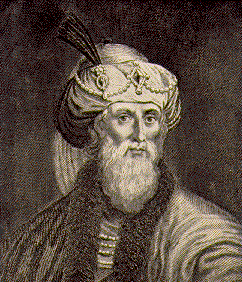The evidence of a continuing exile from Josephus
 Although the writings of Josephus for the most part downplay the historical exile to Babylon and at times over emphasize the positive attributes of how Jewish people can contribute to their alien environments, coupled with the fact that Josephus himself spent the last three decades living in luxurious exile in Rome, it is not surprising that he does not emphasize restoration.[1] Josephus, however, does speak of two separate instances where certain Jews who claimed to be sign prophets promised their followers signs of coming salvation; Theudas and the Egyptian.[2]
Although the writings of Josephus for the most part downplay the historical exile to Babylon and at times over emphasize the positive attributes of how Jewish people can contribute to their alien environments, coupled with the fact that Josephus himself spent the last three decades living in luxurious exile in Rome, it is not surprising that he does not emphasize restoration.[1] Josephus, however, does speak of two separate instances where certain Jews who claimed to be sign prophets promised their followers signs of coming salvation; Theudas and the Egyptian.[2]
Theudas came upon the scene during the reign of the procurator Fadus (44-?46 c.e.), he most likely was responding to friction arising over a dispute about who controlled the vestments of the High Priest.[3] Although Josephus calls Theudas an impostor, Theudas convinced his followers to take all of their possessions and to follow him to the Jordan River where he promised that upon his commanded the Jordan river would part allowing his followers to cross. Fadus however sent a squadron of cavalry and took Theudas’ group by surprise, capturing most of them and beheading Theudas on the spot. The head was displayed around Jerusalem to discourage other would be prophets.[4]
Thaedus’ intentions of parting the Jordan river, strongly evokes the re-enactment of the first exodus, by associating their actions with the splitting of the Re(e)d Sea (Ex. 12.29-14.30) and the Jordan river (Josh. 3-4), this group may have thought they were enacting the Isaianic second exodus thus bringing about the end of the exile by ridding the Jews of their foreign yoke and partaking of the land promised to them.
Josephus’ account of the Egyptian is part of a longer narrative summarizing the events of Palestine under Felix, who was procurator from 60-52 c.e.[5] Like Theudas, Josephus calls the Egyptian a false prophet, but by Josephus’ own estimation the Egyptian seemingly garnered a much wider following.[6] Although there are discrepancies in Josephus’ own accounts of the Egyptian, in the Antiquities Josephus tells us that the Egyptian first came to Jerusalem and raises a following there, the mass then marches from Jerusalem to the Mt. of Olives, outside the city walls, and there the Egyptian claimed that the walls would miraculously fall down at his command, allowing his followers to enter, and probably enact an armed invasion of Jerusalem.[7]
Here too the Egyptian modeled his actions upon the events surrounding the first exodus, namely in a re-enacting of the original entrance into the Promised Land by the defeat of Jericho by Joshua, by claiming to bring down the walls of Jerusalem. The Egyptian was most likely expecting divine intervention to help them in this new defeat of the Romans and in ridding the land of the political oppressors.[8]
Evans suggests both of these ‘prophets’ were probably laying claim to the promises in Deuteronomy 18.15-22 that someday God would ‘raise up a prophet like Moses.’[9] The promises of Isaiah 40 might have also contributed to the actions of the “prophets” to start in the wilderness thus drawing continuity between their own actions and the “high way” of God in the second exodus.[10] Because these signs recalled both the exodus and the conquest they were almost certainly meant as eschatological signs.[11] There is little doubt that in both of these cases some sort of restoration was still pined for, and the fact that both events were modeled after the events surrounding the first exodus gives credence to the idea that a new exodus from exile must have still resonated with many Jews, for it is unlikely that these two men would have collected ‘masses’ of followers, if there was a general consensus that the restoration was complete and thus the exilic experience was over.[12]
[1] Louis H. Feldman, "Restoration in Josephus," in Restoration: Old Testament, Jewish, and Christian Perspectives, ed. James M. Scott (JSJSup 72; Leiden: Brill, 2001), 226, 29.
[2] The account of Theudas is found in Ant. 20.5.1, 97-98; and the account of the Egyptian Jew is found in JW 2.13.4-5, 258-263; Ant. 20.8.6, 167-172.
[3] Rebecca Gray, Prophetic Figures in Late Second Temple Jewish Palestine: The Evidence from Josephus (New York: Oxford University Press, 1993), 114-15.
[4] Gray, Prophetic Figures, 115.
[5] For the larger narrative see, JW 2.13.4-5, 252-265; Ant. 20.8.6, 160-172.
[6] In Acts 5.36 Gamaliel 1 claims that Theudas had about 400 followers while Josephus cites that Theudas was able to convince the ‘majority of the masses.’ This is contrasted with Josephus account of the Egyptian in JW where he claims the followers to be in the 30,000 range.
[7] On the possible reasons for the discrepancies between JW and the Ant. see Gray, Prophetic Figures, 116-17.
[8] Gray, Prophetic Figures, 119.
[9] Craig A. Evans, "Aspects of Exile and Restoration in the Proclamation of Jesus and the Gospels," in Exile: Old Testament, Jewish, and Christian Conceptions, ed. James M. Scott (JSJSup 56; Leiden: Brill, 1997), 303.
[10] Craig A. Evans, "The Beginning of the Good News and the Fulfilment of Scripture in the Gospel of Mark," in Having the Old Testament in the New Testament, ed. Stanley E. Porter (McMaster New Testament Studies; Grand Rapids: Eerdmans, 2006), 101.
[11] E. P. Sanders, Jesus and Judaism (Philadelphia: Fortress Press, 1985), 171; Richard A. Horsley, Christian Origins (A People's History of Christianity 1; Minneapolis: Fortress Press, 2005), 30.
[12] Horsley, Christian Origins, 29. Josephus may have used these instances to reassure the Romans that he supported the swift action taken against these false prophets, but nevertheless these ‘rebels’ were able to garner popular support precisely because exilic notions still prevailed. See Steve Mason, Josephus and the New Testament (Peabody: Hendrickson, 1992), 110.




No comments:
Post a Comment